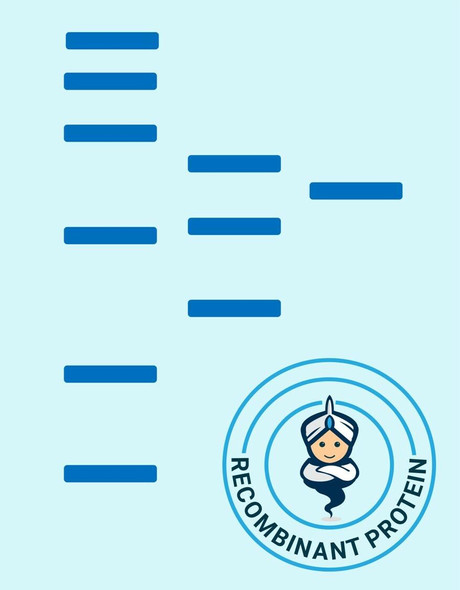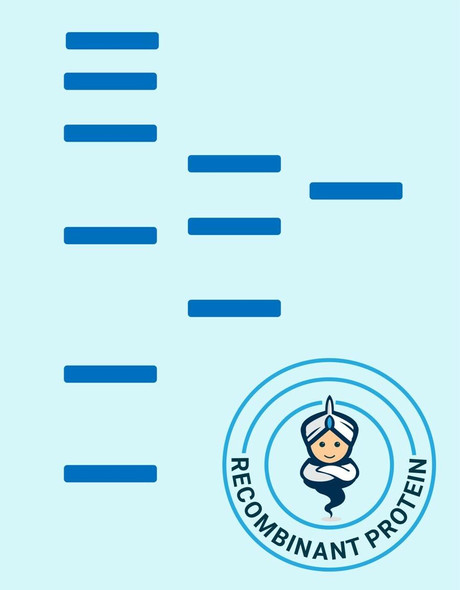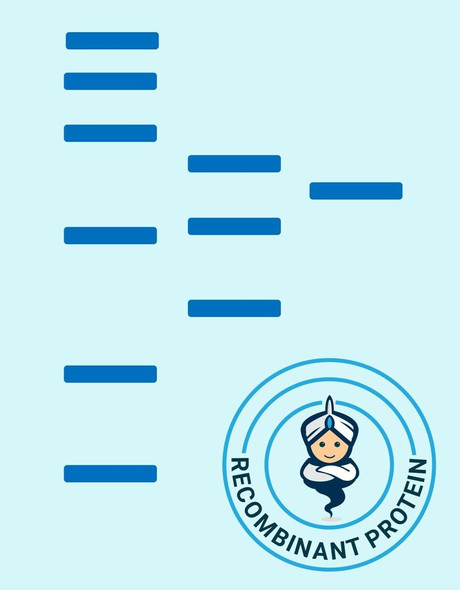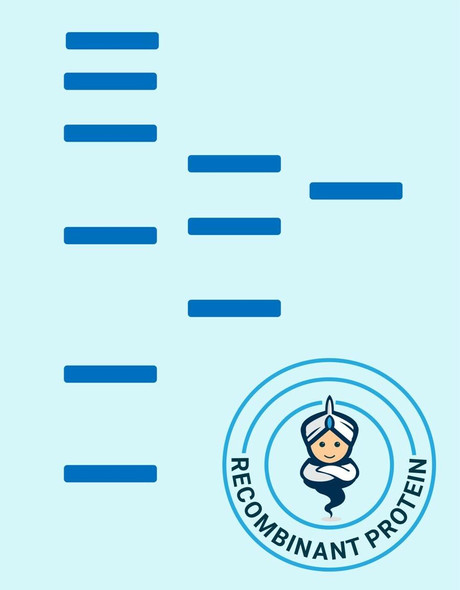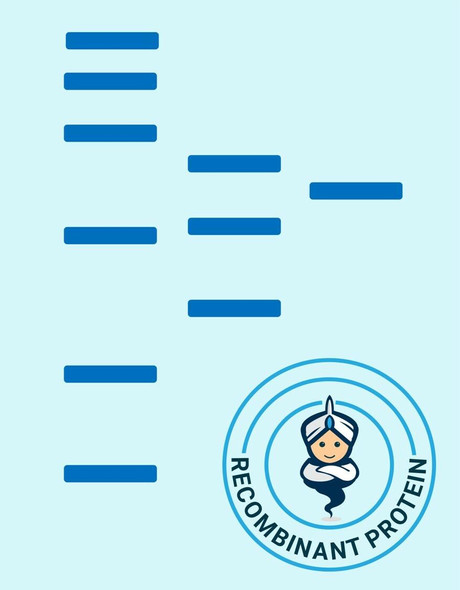Human MIP 5 (68 a.a) Recombinant Protein (RPPB1231)
- SKU:
- RPPB1231
- Product Type:
- Recombinant Protein
- Species:
- Human
- Uniprot:
- Q16663
- Research Area:
- Chemokines
Description
| Product Name: | Human MIP 5 (68 a.a) Recombinant Protein |
| Product Code: | RPPB1231 |
| Size: | 25µg |
| Species: | Human |
| Target: | MIP 5 (68 a.a) |
| Synonyms: | Small inducible cytokine A15 precursor, CCL15, Macrophage inflammatory protein 5, MIP-5, MIP5, Chemokine CC-2, HCC-2, NCC-3, MIP- 1 delta, Leukotactin-1, LKN-1, Mrp-2b, C-C motif chemokine 15. |
| Source: | Escherichia Coli |
| Physical Appearance: | Sterile Filtered White lyophilized (freeze-dried) powder. |
| Formulation: | MIP5 was lyophilized from a 0.2�m filtered concentrated solution containing PBS, pH-7.4. |
| Solubility: | It is recommended to reconstitute the lyophilized MIP5 in sterile 18M?-cm H2O not less than 100�g/ml, which can then be further diluted to other aqueous solutions. |
| Stability: | Lyophilized MIP-5 although stable at room temperature for 3 weeks, should be stored desiccated below -18°C. Upon reconstitution CCL15 should be stored at 4°C between 2-7 days and for future use below -18°C.For long term storage it is recommended to add a carrier protein (0.1% HSA or BSA).Please prevent freeze-thaw cycles. |
| Purity: | Greater than 97.0% as determined by:(a) Analysis by RP-HPLC.(b) Analysis by SDS-PAGE. |
| Amino Acid Sequence: | SFHFAADCCT SYISQSIPCS LMKSYFETSS ECSKPGVIFL TKKGRQVCAK PSGPGVQDCM KKLKPYSI |
| Biological Activity: | Measured by its ability to chemoattract THP-1 human acute monocytic leukemia cells. The ED50 for this effect is typically 2-4ng/ml. |
CCL15, a new human CC chemokine, was isolated from a human fetal spleen cDNA library. CCL15 cDNA encodes a predicted 113 amino acid (aa) protein containing a putative signal peptide of 21 amino acids that is cleaved to generate a 92 aa residue mature protein. Within the CC family members, human CCL15 shares 45%, 44%, 35%, and 30% aa homology with mouse C10, human MPIF-1, human HCC-1, and mouse MIP-1A, respectively. The gene for MIP-5 is found on chromosome 17 where the genes for most of the human CC chemokines are located. Human CCL15 is expressed in T and B lymphocytes, NK cells, monocytes and monocyte-derived dendritic cells. Human MIP-5 is chemotactic for T cells and monocytes and has been shown to induce calcium flux in human CCR-1-transfected cells.
Macrophage Inflammatory Protein-5 Human Recombinant produced in E.Coli is a single, non-glycosylated, polypeptide chain containing 68 amino acids and having a molecular mass of 7.4kDa. The MIP5 is purified by proprietary chromatographic techniques.
| UniProt Protein Function: | CCL15: Chemotactic factor that attracts T-cells and monocytes, but not neutrophils, eosinophils, or B-cells. Acts mainly via CC chemokine receptor CCR1. Also binds to CCR3. CCL15(22-92), CCL15(25-92) and CCL15(29-92) are more potent chemoattractants than the small-inducible cytokine A15. Belongs to the intercrine beta (chemokine CC) family. |
| UniProt Protein Details: | Protein type:Secreted; Motility/polarity/chemotaxis; Secreted, signal peptide Chromosomal Location of Human Ortholog: 17q12 Cellular Component: extracellular space Molecular Function:heparin binding; chemokine activity; receptor binding; chemoattractant activity Biological Process: cellular calcium ion homeostasis; positive chemotaxis; cell-cell signaling; immune response; chemotaxis; signal transduction |
| NCBI Summary: | This gene is located in a cluster of similar genes in the same region of chromosome 17. These genes encode CC cytokines, which are secreted proteins characterized by two adjacent cysteines. The product of this gene is chemotactic for T cells and monocytes, and acts through C-C chemokine receptor type 1 (CCR1). The proprotein is further processed into numerous smaller functional peptides. Naturally-occurring readthrough transcripts occur from this gene into the downstream gene, CCL14 (chemokine (C-C motif) ligand 14). [provided by RefSeq, Jan 2013] |
| UniProt Code: | Q16663 |
| NCBI GenInfo Identifier: | 3915594 |
| NCBI Gene ID: | 6359 |
| NCBI Accession: | Q16663.2 |
| UniProt Secondary Accession: | Q16663,Q9UM74, B2RU34, E1P651, |
| UniProt Related Accession: | Q16663 |
| Molecular Weight: | 12,248 Da |
| NCBI Full Name: | C-C motif chemokine 15 |
| NCBI Synonym Full Names: | chemokine (C-C motif) ligand 15 |
| NCBI Official Symbol: | CCL15�� |
| NCBI Official Synonym Symbols: | LKN1; NCC3; SY15; HCC-2; LKN-1; MIP-5; NCC-3; SCYL3; MIP-1D; MRP-2B; SCYA15; HMRP-2B; MIP-1 delta�� |
| NCBI Protein Information: | C-C motif chemokine 15; leukotactin 1; chemokine CC-2; new CC chemokine 3; small-inducible cytokine A15; macrophage inflammatory protein 5; small inducible cytokine subfamily A (Cys-Cys), member 15 |
| UniProt Protein Name: | C-C motif chemokine 15 |
| UniProt Synonym Protein Names: | Chemokine CC-2; HCC-2; Leukotactin-1; LKN-1; MIP-1 delta; Macrophage inflammatory protein 5; MIP-5; Mrp-2b; NCC-3; Small-inducible cytokine A15Cleaved into the following 3 chains:CCL15(22-92); CCL15(25-92); CCL15(29-92) |
| Protein Family: | C-C motif chemokine |
| UniProt Gene Name: | CCL15�� |
| UniProt Entry Name: | CCL15_HUMAN |





